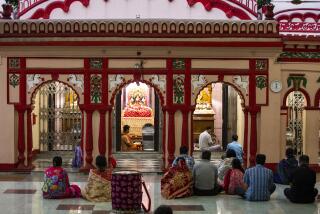‘Interlok’ stirs ethnic, political waters in Malaysia
KUALA LUMPUR, Malaysia — When Abdullah Hussain released his novel “Interlok” in 1971, the author could not have known the impact it would have on this Muslim-majority country. Few at the time read the Malay-language book, which portrays the interlocking lives of ethnic Malay, Chinese and Indian families in pre-independence British Malaya.
But four decades later, the book became a sensation. It has galvanized the country’s Indians — a mostly poor minority that is traditionally known for political passivity — after they objected to its portrayal of Indian characters. This has altered the political landscape in advance of upcoming national elections, expected to be the most competitive in years.
During a year-long national debate, punctuated by death threats and breathless news coverage, the book reopened the old but familiar wounds of ethnicity (or what Malaysians refer to as race). Malaysia suffered violent race riots in 1969, and since then its Malay Muslim majority and sizable Indian and Chinese minorities have coexisted uneasily, held together by the authoritarian-leaning ruling coalition, Barisan Nasional.
“It’s one of the only books that has tried to address the complexities of ethnicity in Malaysia,” said Shamsul Amri Baharuddin, head of the Institute of Ethnic Studies at the National University of Malaysia. The debate’s contours resemble the American culture wars of the 1990s, complete with competing religious and ethnic grievances and accusations that elites have exploited race for political gain.
“Interlok” shot from obscurity to prominence in late 2010, when the Ministry of Education placed it on the syllabus of public high schools in the Kuala Lumpur area. The story, set in the first half of the 20th century, follows three characters — Seman, Chin Huat and Maniam — as their lives eventually intertwine during British colonization, the Japanese occupation and independence.
In one passage, the book describes the migration of Indians from the southern subcontinent, where some were members of the pariah caste. Parents of Indian students who read the book were outraged by the use of the word “pariah” and descriptions of Indian characters as black-skinned.
“The book is designed to indoctrinate Indian children that they are immigrants in this country, that they should be grateful to the Malays for letting them stay,” said Thasleem Mohamed Ibrahim, who became an organizer of the anti-”Interlok” movement, which has collected 50,000 signatures demanding that the novel be removed from the syllabus.
As the protest movement gathered steam, gaining support from Chinese and Malay groups, the government began to backtrack. It created an amended version before finally agreeing to remove the book entirely for the 2012 school year.
Activists celebrated the victory as a milestone in Indian political consciousness. “In the past, we have not been able to see issues like this to completion. But this time, we completed the mission,” said N.S. Krishna, a videographer who created short films about the issue for YouTube.
Still, not everyone was pleased. “Today you stop the book and tomorrow what are you going to stop?” asked Indian author and academic Ambigapathy Pandian. “The Indian community should be mature enough to accept these criticisms.” Others noted that sensitive words such as pariah were in use during the period in which the book is set, and that the characters’ attitudes toward race are historically accurate.
Abdullah Hussain, a 92-year-old Malay who is confined to a wheelchair, remains puzzled by the controversy over this one of more than two dozen novels he has written. After breaking down in tears during an interview with a prominent newspaper, he has largely withdrawn from public life. In an email exchange, he maintained that his book was not insensitive to Indians, and that its characters were based on real people and extensive research. “They politicized my book,” he wrote.
Although “Interlok” is gone from high schools, it has become shorthand for a spike in ethnic tensions over the last decade, which has been driven at least in part by affirmative action policies designed to help Malays advance. Hundreds of thousands of Chinese have left the country for work abroad, saying the laws discriminate against them.
With elections due by early next year, “Interlok” has increased the importance of Indian voters, who could prove decisive in determining the winner. Barisan Nasional, which has held power since independence, suffered its worst ever defeat during elections in 2008. It doesn’t want a repeat, said Bridget Welsh, a Malaysia expert at Singapore Management University. “They’re desperate to hold on to power, and they need the Indian vote to win. Everybody sees the withdrawal of ‘Interlok’ for exactly what it is: as an act of political desperation,” she said.
The controversy has not stopped Malaysian artists from addressing sensitive subjects. Last year, a Malaysian-Chinese filmmaker released the racially provocative comedy “Nasi Lemak 2.0,” which set box office records. “Parah,” a play about the “Interlok” controversy, recently drew full houses here.
“Parah’s” director, Jo Kukathas, said that though art was in danger of becoming a battleground for competing ethnic agendas, artists still had an obligation to use their work to bridge the country’s divides.
In the play, the main characters — a group of Indian, Chinese and Malay friends — do what real-life Malaysia seemed incapable of: find common ground through a four-decade-old novel about the country’s sometimes fractured, but ultimately interlocking, groups.
More to Read
The biggest entertainment stories
Get our big stories about Hollywood, film, television, music, arts, culture and more right in your inbox as soon as they publish.
You may occasionally receive promotional content from the Los Angeles Times.










